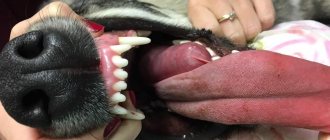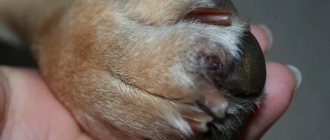Herpes is an infectious disease that affects the upper respiratory tract and reproductive system in animals. The causative agent of herpes is found in 70% of dogs. The susceptibility to the disease does not depend on the gender, age or breed of the dog. But while its presence in most cases does not lead to serious consequences for adults, newborn puppies with herpes almost always die, despite the treatment methods taken. Dogs that have had herpes become lifelong carriers of the virus.
Pathogen
DNA-containing viruses are considered one of the most persistent: by integrating into the host’s body into a deoxyribonucleic acid molecule that implements the genetic program, it provides itself with protection from suppression by the immune system.
The herpesvirus family includes a total of 86 species, some of which infect humans and others of certain animal species. In dogs, the disease is caused by alphaherpesviruses of two serotypes - HSV-1 and HSV-2. They are resistant to low temperatures, devoid of moisture, and can remain viable for several hours on the surface of plastic, wood, fabric or leather. But at temperatures above 90°C, these viruses die after 2-3 days, and ether, chloroform and other disinfectants kill them almost instantly.
Attention! All herpes viruses are species-specific (genetically determined), so neither humans nor other types of domestic animals can in any way become infected with canine herpes.
Sore on a dog's lip
Good afternoon Recently, our pet injured his lip, after which everything healed successfully, but the skin in this place is pink, and the nearby skin is almost black, will the restored area of skin change color or will it remain light? We have an exhibition in 2 weeks, I’m worried that this may interfere with the assessment.
Veterinary
| [29.08.2020 22:55] |
Hello Irina! The ratings are given by judges, not veterinarians - all questions are directed to them. And the skin at the site of injury should gradually acquire a normal color.
Good afternoon Recently, our pet injured his lip, after which everything healed successfully, but the skin in this place is pink, and the nearby skin is almost black, will the restored area of skin change color or will it remain light? We have an exhibition in 2 weeks, I’m worried that this may interfere with the assessment.
Routes of infection
The Herpesviridae virus is transmitted through airborne droplets, sneezing, coughing, licking, eating from a shared bowl, and through sexual contact with an infected dog. After infection, the virus can go into a latent stage for 2-3 months; its activation can be triggered by stress, decreased immunity, or sudden changes in living conditions.
Puppies can become infected from a sick mother when passing through the birth canal. Intrauterine infection is also possible, since herpes viruses are able to cross the placental barrier.
Why is the herpes virus so scary for dogs?
If we talk about the congenital disease of puppies with the herpes virus, the statistics are disappointing. Newborn babies infected with herpes can die within 24 hours. This is due to the fact that the disease affects the body’s immune system, suppresses the immune system, and puppies are not capable of thermoregulation (maintaining optimal body temperature). As a result, babies are unable to suck mother's milk, quickly become weak, suffer from diarrhea (green or yellow stools) and die from suffocation or internal hemorrhage. Since it is almost impossible to make a diagnosis in the first week of a puppy's life, death from the herpes virus is defined as "sudden puppy death."
Newborn puppies are most vulnerable to the virus
To prevent the bitch from becoming infected during the mating process, both dogs must provide blood samples so that tests can be carried out in the laboratory for the presence of the herpes virus. For three weeks before mating, breeding pets are quarantined, that is, they are walked on a leash in places where it is impossible to meet other animals that may be carriers of herpes.
Also, a nursing bitch is protected after giving birth for three weeks. The mother should not have any new contacts that could infect her with the virus. Puppies that are struck by herpes after three to four weeks of age have a much better chance of recovery than newborn babies. However, there will still be complications.
A nursing bitch can infect her entire litter with herpes if she gets sick herself.
The fact is that the herpes virus has the highest concentration in the respiratory organs, without particularly manifesting itself. An animal may well be a carrier of the virus (in its latent form), and the disease can be activated at any moment.
Symptoms
The incubation period of the disease is 6-10 days. In adults, herpes can occur in a mild form; signs of the disease can be very minor. In newborn puppies, the disease usually has an acute course and often ends in death. This is explained by the fact that the colostral immunity, which was formed in them due to the immunoglobulins contained in the colostrum of mother's milk, is not strong enough to cope with the extremely aggressive herpes virus.
Symptoms of herpes in puppies under 2 weeks of age:
- extreme weakness;
- sharp inspiratory shortness of breath, signs of oxygen starvation (it is difficult for the animal to take a deep breath);
- complete lack of appetite (anorexia);
- cough, sneezing;
- profuse drooling;
- serous nasal discharge;
- nosebleeds;
- vomit;
- stomach painful on palpation;
- pinpoint hemorrhages on the mucous membranes (petechiae), pallor of the mucous membranes (thrombocytopenia);
- semi-liquid feces of yellow or green color;
- impaired coordination of movements, convulsions;
- dehydration.
Clinical manifestations of herpes in adult dogs:
- chronic rhinitis, the dog’s nose has hair stuck together with mucus.
- If pneumonia develops, wheezing, coughing, sometimes leading to vomiting.
- When the virus is localized in the epithelial cells of the cornea of the eyes, the dog develops herpetic conjunctivitis - redness of the eyes, lacrimation, photophobia, blepharospasm (involuntary closure of the eyelids) is observed.
- When the mucous epithelium is damaged, blisters appear on the tongue, gums and palate of the animal, after opening which weeping ulcers form.
- Genital herpes manifests itself in the form of ulcers; in males they form on the foreskin, in females - on the inner surface of the genital slit (loop). This hidden location of the rash makes diagnosis difficult; only a qualified specialist can detect external signs of genital herpes in a dog.
Prevention of herpes in animals
There is no vaccine against herpes in dogs. Veterinarians recommend performing the necessary examinations before breeding an animal for the presence of infection.
Important. If the bitch has ever had ulcers on her face, it is highly not recommended to breed her. If offspring are born, it is necessary to provide the puppies with optimal conditions for existence and begin treatment for herpes.
When keeping dogs in kennels, the pregnant individual should be isolated during the last month of gestation and after giving birth, she should be quarantined, provided with good conditions and a nutritious diet.
It is not possible to prevent herpes infection in dogs, because it is contained in external conditions. It is recommended that pet owners limit contact with stray animals.
Diagnostics
If a dog is suspected of having herpes, a series of examinations are prescribed, the purpose of which is to determine whether the Herpesviridae virus is present in its body. They examine blood, discharge from the nose, eyes, and genitals.
Diagnostic methods are:
- Blood test for IgG antibodies. If, as a result of the analysis, the positivity index value is less than 0.8, it is considered that no G antibodies to the herpes virus have been detected.
- Bacteriological analysis. The biomaterial can be blood, saliva, or swabs from the mucous membranes of the pharynx or genitals. The sample is placed in a nutrient medium. If the Herpesviridae virus is present in it, the microorganism actively reproduces; this process is visible under a microscope. The chance of getting false results using this method is almost zero, but the test takes 1-2 weeks to complete.
- PCR method. This method is based on repeated copies of the DNA of the virus. Polymerase chain reaction allows you to identify the pathogen even with its minimal content in the blood. The material can be blood, biopsies, or any biological fluids secreted by the body.
- Enzyme immunoassay blood test. Using ELISA, you can detect the presence of antibodies to a specific virus and determine their concentration, which allows you to identify the pathogen and establish the phase of the disease.
- Immunofluorescence blood test. When conducting a RIF study, the biomaterial is treated with a special substance, under the influence of which antigens to the virus begin to glow in the rays of a fluorescent microscope. This method is considered a good method of express diagnostics, but is effective when the concentration of the pathogen in the blood is high.
Therapy for canine herpes
Even if a virus is detected in the animal’s blood, all the veterinarian can do is prescribe symptomatic treatment, which does not eliminate the disease, but only stops its further development. As for small puppies, they are literally pulled out of the other world: they are placed in a warm and dry place, on a heating pad or under a heating lamp (so that the air temperature is not lower than 30 degrees). Children are given antibiotics and antiviral drugs.
It is important to keep sick puppies warm at all times.
However, even aggressive treatment may not work, and even if the puppies survive for a day or two, further complications can kill them. Babies also die in a short time from damage to the nervous system or respiratory system, or kidney failure.
Adult dogs also cannot be cured. The fact is that gene diseases are too complex for therapy, especially when they are initiated by a regularly mutating virus. Prevention of the disease is also impossible due to the high risks of infection, and keeping your pet in a sterile box will not work.
Herpes infection for dogs is a disease that is easy to catch, but difficult to diagnose and impossible to cure.
Treatment
There are no means today that can completely remove DNA-containing viruses from the human or animal body. All antiviral drugs have a bacteriostatic effect. They do not cause the death of microorganisms, but only suppress their growth and reproduction, forcing them to go into “sleep” mode.
When a dog is diagnosed with a herpes virus infection, adult dogs are prescribed drugs that increase the body's resistance to viruses (Fosprenil, Immunofan, Maxidin). To prevent the development of a secondary infection, the dog may be prescribed a course of antibiotics. The biotonic agent Gamavit and the multivitamin complex SA-37 are used as general tonics. In cases of persistent diarrhea, enterosorbent Polysorb or Diarcan, which has an antibacterial and enveloping effect, are prescribed.
Treatment of newborn puppies consists of symptomatic and supportive therapy. General strengthening, antiviral and antibacterial agents and parenteral nutrition are used. Puppies need to be provided with constant heating - at temperatures above 37°C the virus loses activity. To do this, you can use an incubator, heating pads, and IR lamps.
It is important to know! Even if the lives of puppies who have had herpes can be saved, most of them subsequently experience dysfunction of the nervous system, problems with the kidneys or respiratory organs.
Harmless reasons
In cases where the dog’s behavior does not cause alarm, but there are ulcers on its lips, the following should be excluded:
№
A common phenomenon, occurring more often in English and French bulldogs. There may be no hair at the site of occurrence and there may be weeping. The animal tries to scratch this place - hence the wounds that look like ulcers.
It is best to treat ulcers with antiseptic solutions, and suprastin and tavegil are good for itching.
Injury
When a dog develops a single ulcer on its lip, the possibility of injuring this area with a toy or stick should be excluded. Hunting breeds encounter this problem more often, as they scratch their lips on weeds and branches, which leads to the appearance of small cracks, which transform into ulcers during the healing process.
In most cases, such injuries go away on their own; it is important to prevent contamination of the wound so that inflammation does not start.
Burn
Dogs love to get into tall grass, and this can cause burns on some plants. There is grass that you can burn on without even breaking it, and there are plants that are dangerous if their juice gets on your skin.
In general, such burns do not pose a danger to the dog; the main thing is to promptly treat the wound with an antiseptic and apply anti-inflammatory ointment.
It is more difficult with burns that a pet can receive after touching a hot dish or barbecue (which happens quite often). They take a long time to heal, hurt and prevent the dog from chewing food normally.
An ulcer on the lip can also form because the animal may have hit itself with a claw while scratching its face. Therefore, it is recommended to prevent the appearance of long, sharp nails and trim them in a timely manner. If this does not help, then you need to look for the reason why the dog scratches itself until it bleeds.
Click to see photo
Possible diseases
If, with the appearance of sores on the lips, the pet begins to refuse food, itch or whine heavily, then there is a high risk of developing diseases associated with parasites, fungi and oral infections:
- Contact dermatitis. May cause red sores on the lips of dogs after exposure to a potential allergen. Usually these are toys made of low-quality rubber/plastic, carpets or fabric that the animal can rub its face against. It develops rapidly - a red, weeping spot appears at the point of contact, which after a few hours transforms into a large ulcer. The solution to the problem is only possible if the allergen is eliminated and effective antihistamines are selected.
- Atopic dermatitis. It has similar symptoms to contact allergies, except that the lesions can be located throughout the body and it is caused not by contact with a potential source of allergy, but by ingesting it directly. This could be food or drugs. There are a number of breeds (English and French bulldogs, Shar Peis, Pugs and Yorkies) that are at risk for atopic dermatitis and require a special diet. Even a small piece of cookies or cheese can trigger an allergic reaction.
- Demodecosis. An extremely unpleasant disease, characterized by special symptoms that cause severe suffering to the animal. Demodex is most often found on the face. It may appear as a hard lump on the chin and cheeks. A distinctive feature is a terrible itching, which forces the dog to scratch the lesions until they bleed. Hence the appearance of long-term non-healing ulcers on the lips. The main thing in the treatment of demodicosis is a correct diagnosis and selected medications. Demodicosis can be confused with acne and insect bites (ants and even mosquitoes).
- Lichen. This disease is of fungal origin and is extremely dangerous because not only the pet suffers, but also its owners, since all family members usually become infected. An animal can pick it up after interacting with an infected dog or cat (most often). Localization of lesions throughout the body - usually the torso, less often the muzzle. At the site of manifestation, hair falls out and a weeping appearance appears, reminiscent of an ulcer. To make a diagnosis, a scraping is taken and microscopy or bacterial culture is performed to determine the fungal culture. Then antimycotic drugs are selected.
- Cheilitis. A disease that is never isolated, since there are always factors that provoke it, such as oral infections, bleeding gums or rotting teeth. At the initial stage, a hardened area appears on the lip, from which pus comes out when pressed. As the process progresses, abundant weeping appears, which is why the wound looks like an ulcer. Treatment includes treating the oral cavity with antiseptic solutions and special antibacterial ointments.
Cheilitis: external signs, types, causes
In veterinary medicine, seizures in dogs or cheilitis refer to the field of dentistry, which is responsible for the healthy condition of the oral cavity or mouth of the animal as a whole.
Externally, this disease can be determined by the appearance of the following signs:
- scabs or dead pieces of whitish skin at the junctions of the edge of the lip and the skin, which gradually peel off and open weeping, painful wounds;
- nodular dense formations on the hair follicle, when opened, pus is released;
- inflammation of wrinkles and folded areas of the skin of the lower lip at the point of contact with the upper fangs;
- weeping wounds in the folds of the jowls and lips.
Depending on the causes and external form of manifestation, cheilitis is divided into four types:
- Catarrhal. Differences: uniform inflammation of the lips, redness, peeling of the epithelium. Reason: mechanical damage to the lips and mucous membrane: injuries, cuts, punctures, scratches, bites, chemical exposure: accidental contact with hazardous substances.
- Glandular. Differences: extensive swelling of the internal mucous membrane of the labial glands, discharge of purulent secretion with the subsequent formation of thickenings and bumps, unpleasant odor from the mouth. Cause: trauma, as a starting mechanism, from dental damage or external mechanical influences, fungal and viral infections, as a consequence.
- Eczematous. Differences: inflammation and redness of the lips, peeling, thickening in the form of ulcers, weeping tears in the outer crust. Reason: allergic reactions to medications, food products against the background of vitamin deficiency in B-vitamins.
- Fungal. Differences: there is a white film coating on the lips with bleeding at the tears, dry lips and, as a result, the dog constantly licks them, pain when opening the mouth. Reason: fungal infections, seizures manifest themselves as a secondary disease against the background of oral dysbiosis, a general decrease in immunity, lack of A and B vitamins, digestive disorders and carbohydrate metabolism, other inflammations of the oral cavity, and overdose of medications.
Observations show that snags most often appear in dogs with sagging jowls, the accidental damage of which is more likely. Another risk group is representatives of hunting breeds: spaniels, setters, greyhounds, which in the process of chasing injure the mucous membrane of the lips with branches and grasses.










